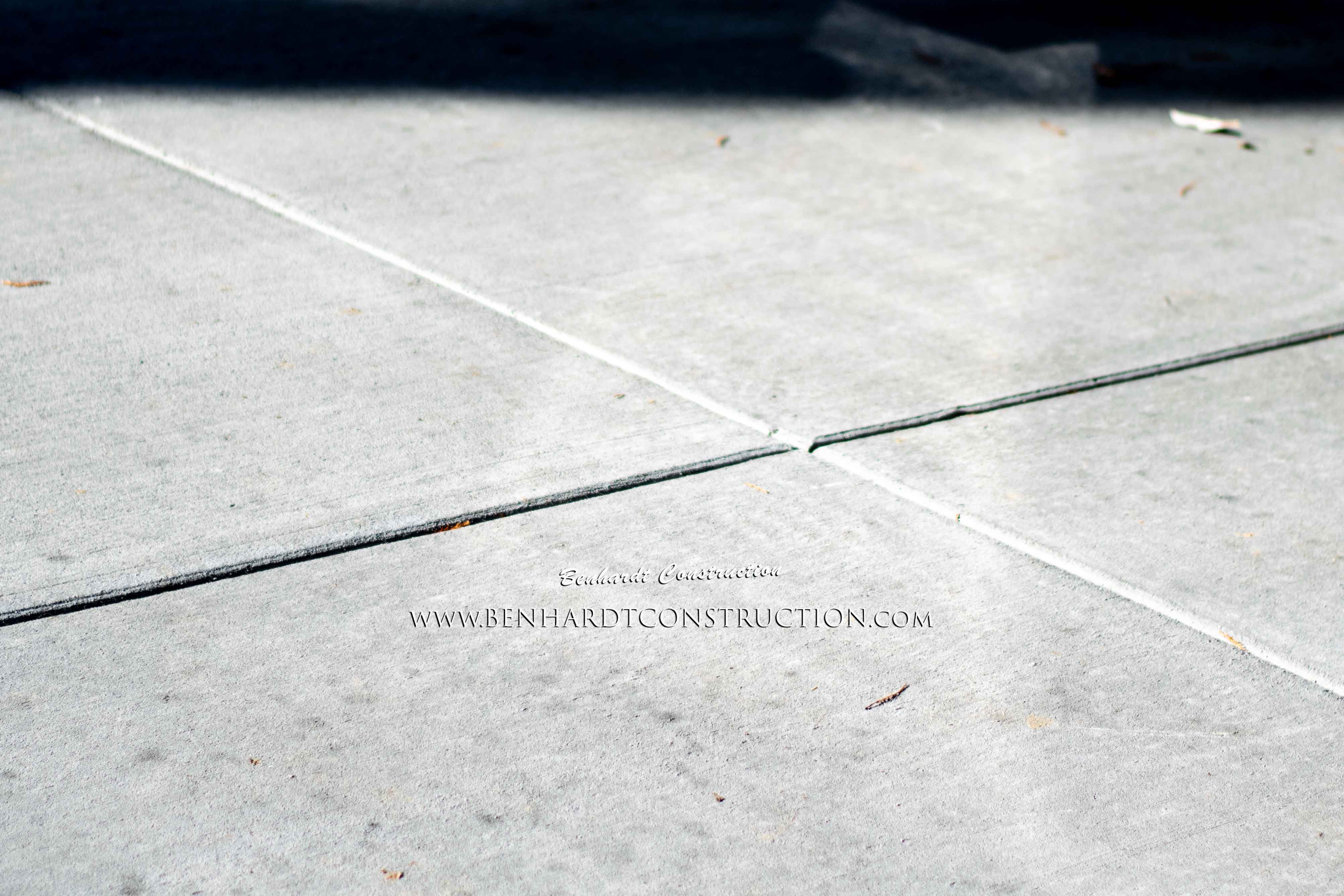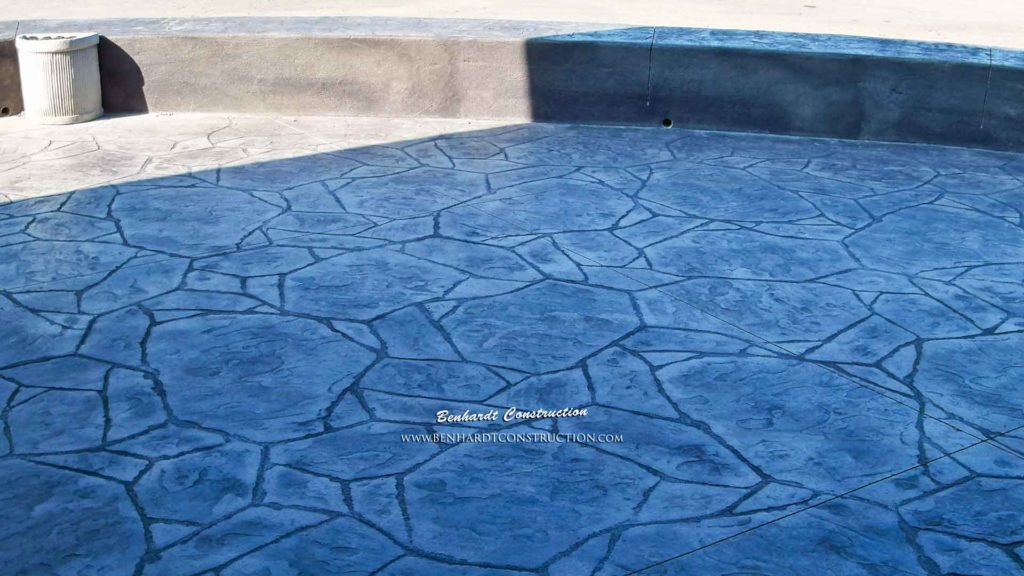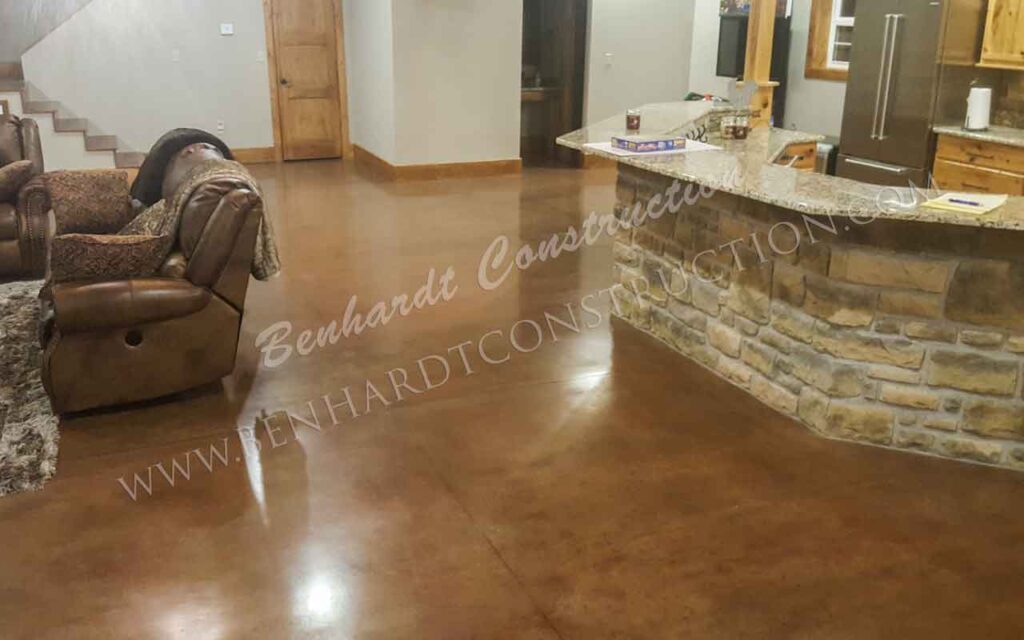Concrete Finish Options Explained
This webpage article will explain these
Four Concrete Finish Types:
- Slick Troweled Concrete Finish
- Broom Concrete Finish
- Exposed Aggregate Concrete Finish
- Stamped Concrete Finish

Brief synopsis of what concrete actually is:
Concrete seems to come in all shapes and sizes yet, at it’s core it’s simply three main components
The three main components of concrete is Portland cement, aggregate (i.e. rock, sand) and water
The paste (cement and water) coats the aggregate (rock, sand) and through hydration the paste hardens, strengthens and creates concrete
The key to strong concrete is in the proportions one uses of the three components. Water is the easiest component to over proportion.
The more water one uses in the mix the more fluid the mixture becomes.
It becomes easier to mix, work with and – to a point – easier to finish. The downside to over proportioning the water is weaker concrete strength.
The typical mix ratio of concrete is 10 to 15 percent cement, 60 to 75 percent aggregate and 15 to 20 percent water.
The intended use for the concrete, budget and personal taste are determining factors as to which concrete finish is perfect for your concrete project
You should now have a basic understanding of what concrete is.
Slick Troweled Concrete Finish
Slick Troweled Concrete is created when a steel hand trowel or machine is used by the cement mason to close the exposed surface of the concrete project.
Typically, slick troweled concrete can be found as garage floors, basement floors, warehouse floors and covered front porches
More labor and time is required to produce the Slick Troweled Concrete Finish as the concrete needs to be hard enough for the cement finisher to walk, kneel on, ride or walk behind a mechanical finish trowel machine.
Once the concrete becomes hard enough to stand, kneel, walk or ride on – there is a limited window of time the finisher has to ‘close the surface’ before the concrete hardens beyond being able to be worked
The benefits of Slick Troweled Concrete is ease of cleaning. Slick troweled concrete is easy to sweep and mop. Hose it down and squeegee off!
The pitfall to Slick Troweled Concrete is that when it’s damp or wet it’s – well – slick…There is minimal traction to this finished product if it’s wet or your shoes or wet from rain or snow.
Broom Concrete Finish

Broom Finished Concrete is similar to Slick Troweled Concrete in that both contain the same ingredients.
The surface of Broom Finished Concrete gets closed and then a specialty broom attachment is pulled across the surface to create a distinct rough texture.
This method does not require that the finisher close the surface by hand
Although the majority of Benhardt Construction’s Broom Finished Concrete Projects are closed by hand before brooming.
While an ‘an extra step’ I have found that this provides a very consistent texture that is very appealing to the eye upon being ‘broomed’
The benefits of Broom Finished Concrete is that it has good traction and is visually appealing.
The pitfall to Broom Finished Concrete is that it’s a little harder to clean since it has the rough texture.
Exposed Aggregate Concrete Finish

Exposed Aggregate Concrete is the first finished concrete product on the list that uses a different aggregate than that of Slick Troweled or Broom Finished.
The reason is that the aggregate is revealed or ‘exposed’ through a multi step process that removes the cement or ‘paste’ from the exposed surface area.
The Slick Trowel Concrete and Broom Finished Concrete utilize limestone whereas Exposed Aggregate Concrete offers plenty of river stone options.
Using a smaller, rounder stone one can find colors ranging from blues, to browns, to reds and greens. The concrete is placed or poured and finished very similar to the already mentioned.
Then a retarding chemical is used on the surface of the concrete which is intended to be exposed.
Usually left overnight, the surface of the concrete is washed with water to remove the cement paste on the surface the following day. With the assistance of low pressure washer and soft bristle scrub broom
The rest of the concrete is fine as the retarding agent is not deep penetrating and it only affects the upper surface
The removal of the cement paste reveals all the beautiful aggregates that otherwise would be hidden in a typical concrete project
The benefits of Exposed Aggregates is the pure beauty, uniqueness and elegance of the finished concrete project
The pitfall is that one wants to be careful with the size aggregate they chose.
The smaller the better because the larger the stone the more space in between the stones for dirt and debris to collect, making furniture harder to move along with walking in formal wear more difficult.
Stamped Concrete Finish

Stamped Concrete can be finished to mimic stone, brick, wood and many other materials.
A variety of colors that can be placed into the concrete as dyes and pigments along with the release agents that assist the stamps from not sticking to the concrete. (Just like flour when making biscuits)
The process for finishing Stamped Concrete is very similar to what we already learned.
If there is to be a color in the concrete itself it will be added at the concrete plant or on the job site.
The concrete will also contain a smaller aggregate to ensure uniform consistency throughout the stamp and allow for the aggregate to not be pushed too far below the surface by the stamp.
The concrete will be hand worked by a finisher as before and then the stamping will take place.
Very large and heavy rubber mats with the stamped concrete texture or stamped concrete pattern you chose will be placed in a pattern after the release (flour) has been spread across the surface area.
The stamping takes place and the molded textures create the desired effect in the surface of the concrete. The stamps are removed one at a time and placed in a new location to continue stamping the surface of the concrete.
This process continues until the entire surface has been stamped properly
Then, depending upon numerous factors related to timing –
Control joints are saw cut into the surface of the concrete patio and then power washed to remove any extra release agent from the surface of the concrete before Concrete Sealer can be applied after allowed to dry.
The pitfalls of Stamped Concrete is high cost from requiring the most materials and labor. Stamped Concrete needs sealing more frequently than the concrete finishes mentioned earlier in this article to protect coloring.
The benefits Is Stamped Concrete is stunning.
Stamped Concrete works great around pools, outdoor kitchens and patios, wineries – heck you name it really. There is a multitude of choices across the board that will suit your needs and tastes
Decorative Concrete – (Bonus 5th Type of Concrete Finish)

Decorative Concrete for the most part, pertains to enhancements one can do to existing concrete.
Although, stamped concrete, by definition, is decorative concrete.
The Decorative Concrete spoken of here is when acids, stains, sprays, binders and epoxies are in play.
These are used to make changes to the surface appearance of the current concrete surface.
Acid Stained Concrete
Metallic Epoxy
Vinyl Chip Epoxy
Polished Concrete
Troweled Concrete Overlays
Stamped Concrete Overlays
Now You Know the Four (Five) Concrete Finish Options for Your Concrete Project
Having a basic understanding of what concrete is and the concrete finishes that are available to you